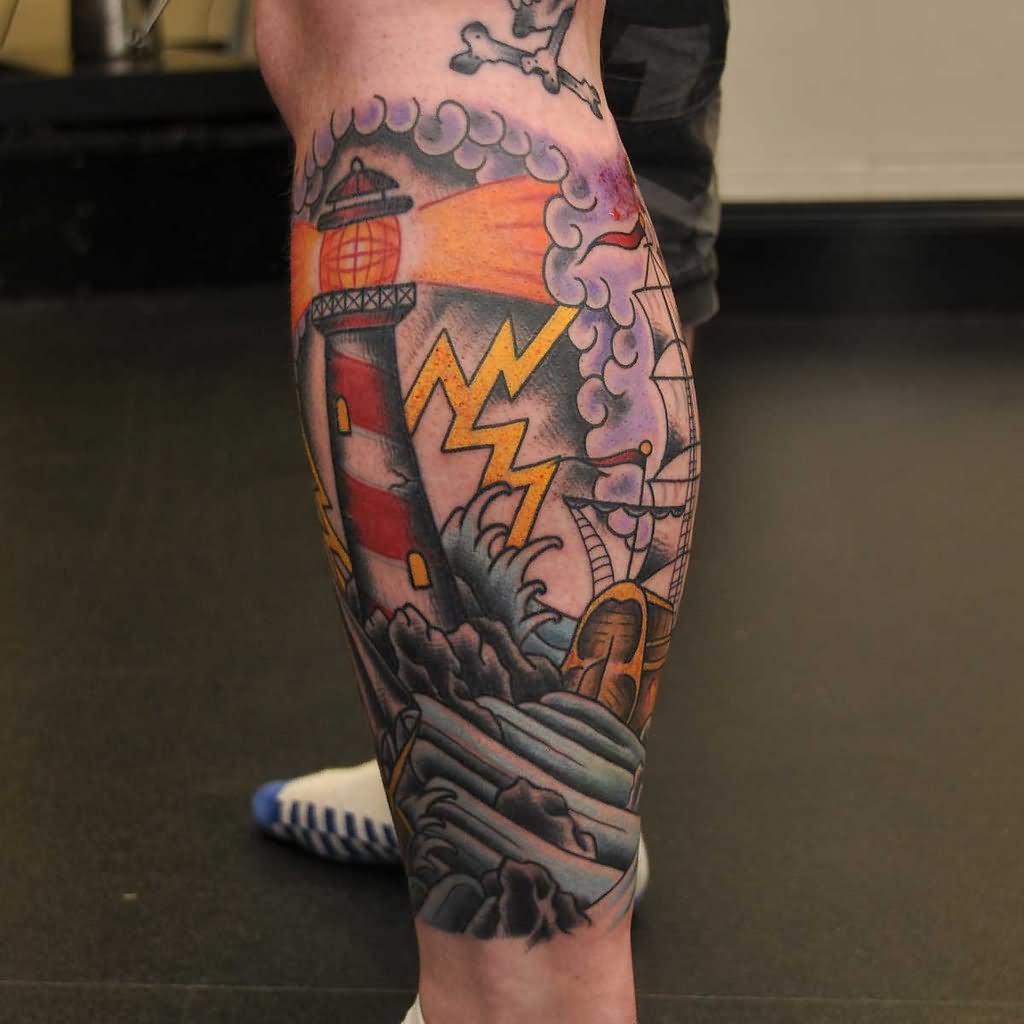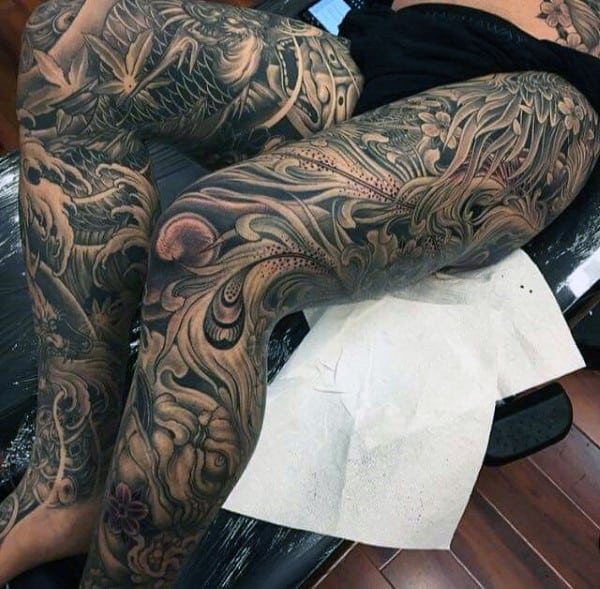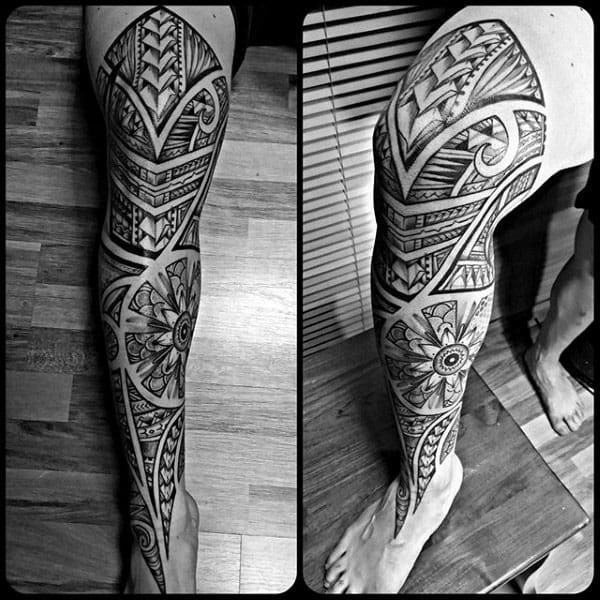35 Awesome Lighthouse Tattoos On Legs The word tattoo, or tattow in the 18th century, is a loanword from the Samoan wordtatau, meaning "to strike". The Oxford English Dictionary offers the etymology of tattoo as "In 18th c. tattaow, tattow. FromPolynesian (Samoan, Tahitian, Tongan, etc.) tatau. InMarquesan, tatu." Prior to the importation of thePolynesian word, the practice of tattooing had been described in the West aspainting, scarring or staining.The etymology of the body modification term is not to be confused withthe origins of the word for the military drumbeat or performance — see military tattoo. In this case, theEnglish word tattoo is derived from the Dutch word taptoe.The very first written reference to the word tattoo (or tatau)seems in the journal of Joseph Banks (24 February 1743 – 19 June 1820),the naturalist aboard explorer James Cook's ship HMS Endeavour: "I shall nowmention the way they mark themselves indelibly, everysingle of them is so marked by their humour or disposition".[5] The word tattoowas brought to Europe by Cook, when he returned in 1769 from his first voyage to Tahiti and New Zealand. In his narrative of the voyage,he refers to an operation called "tattaw".Tattoo enthusiasts could refer to tattoos as "ink","pieces", "skin art", "tattoo art", "tats" or "work"; to the creators as "tattooartists", "tattooers" or "tattooists"; and to areasexactly where they operate as "tattoo shops", "tattoostudios" or "tattoo parlors".Mainstream art galleries hold exhibitions of each standard and custom tattoo designs, such as Beyond Skin, at the Museumof Croydon. Copyrighted tattoo designs that are mass-created and sent to tattoo artists are identified as"flash", a notable instance of industrial design and style.[8] Flashsheets are prominently displayed in numerous tattoo parlorsfor the purpose of offeringboth inspiration and prepared-made tattoophotos to consumers.The Japanese word irezumi signifies "insertion of ink"and can mean tattoos using tebori, theconventional Japanese hand method, a Western-style machine or any technique of tattooing using insertion of ink.The most common word employed for classic Japanese tattoostyles is horimono. Japanese may possibly use the wordtattoo to mean non-Japanese types of tattooing.
The word tattoo, or tattow in the 18th century, is a loanword from the Samoan wordtatau, meaning "to strike". The Oxford English Dictionary offers the etymology of tattoo as "In 18th c. tattaow, tattow. FromPolynesian (Samoan, Tahitian, Tongan, etc.) tatau. InMarquesan, tatu." Prior to the importation of thePolynesian word, the practice of tattooing had been described in the West aspainting, scarring or staining.The etymology of the body modification term is not to be confused withthe origins of the word for the military drumbeat or performance — see military tattoo. In this case, theEnglish word tattoo is derived from the Dutch word taptoe.The very first written reference to the word tattoo (or tatau)seems in the journal of Joseph Banks (24 February 1743 – 19 June 1820),the naturalist aboard explorer James Cook's ship HMS Endeavour: "I shall nowmention the way they mark themselves indelibly, everysingle of them is so marked by their humour or disposition".[5] The word tattoowas brought to Europe by Cook, when he returned in 1769 from his first voyage to Tahiti and New Zealand. In his narrative of the voyage,he refers to an operation called "tattaw".Tattoo enthusiasts could refer to tattoos as "ink","pieces", "skin art", "tattoo art", "tats" or "work"; to the creators as "tattooartists", "tattooers" or "tattooists"; and to areasexactly where they operate as "tattoo shops", "tattoostudios" or "tattoo parlors".Mainstream art galleries hold exhibitions of each standard and custom tattoo designs, such as Beyond Skin, at the Museumof Croydon. Copyrighted tattoo designs that are mass-created and sent to tattoo artists are identified as"flash", a notable instance of industrial design and style.[8] Flashsheets are prominently displayed in numerous tattoo parlorsfor the purpose of offeringboth inspiration and prepared-made tattoophotos to consumers.The Japanese word irezumi signifies "insertion of ink"and can mean tattoos using tebori, theconventional Japanese hand method, a Western-style machine or any technique of tattooing using insertion of ink.The most common word employed for classic Japanese tattoostyles is horimono. Japanese may possibly use the wordtattoo to mean non-Japanese types of tattooing.

![]()
![]()
 The word tattoo, or tattow in the 18th century, is a loanword from the Samoan wordtatau, meaning "to strike". The Oxford English Dictionary offers the etymology of tattoo as "In 18th c. tattaow, tattow. FromPolynesian (Samoan, Tahitian, Tongan, etc.) tatau. InMarquesan, tatu." Prior to the importation of thePolynesian word, the practice of tattooing had been described in the West aspainting, scarring or staining.The etymology of the body modification term is not to be confused withthe origins of the word for the military drumbeat or performance — see military tattoo. In this case, theEnglish word tattoo is derived from the Dutch word taptoe.The very first written reference to the word tattoo (or tatau)seems in the journal of Joseph Banks (24 February 1743 – 19 June 1820),the naturalist aboard explorer James Cook's ship HMS Endeavour: "I shall nowmention the way they mark themselves indelibly, everysingle of them is so marked by their humour or disposition".[5] The word tattoowas brought to Europe by Cook, when he returned in 1769 from his first voyage to Tahiti and New Zealand. In his narrative of the voyage,he refers to an operation called "tattaw".Tattoo enthusiasts could refer to tattoos as "ink","pieces", "skin art", "tattoo art", "tats" or "work"; to the creators as "tattooartists", "tattooers" or "tattooists"; and to areasexactly where they operate as "tattoo shops", "tattoostudios" or "tattoo parlors".Mainstream art galleries hold exhibitions of each standard and custom tattoo designs, such as Beyond Skin, at the Museumof Croydon. Copyrighted tattoo designs that are mass-created and sent to tattoo artists are identified as"flash", a notable instance of industrial design and style.[8] Flashsheets are prominently displayed in numerous tattoo parlorsfor the purpose of offeringboth inspiration and prepared-made tattoophotos to consumers.The Japanese word irezumi signifies "insertion of ink"and can mean tattoos using tebori, theconventional Japanese hand method, a Western-style machine or any technique of tattooing using insertion of ink.The most common word employed for classic Japanese tattoostyles is horimono. Japanese may possibly use the wordtattoo to mean non-Japanese types of tattooing.
The word tattoo, or tattow in the 18th century, is a loanword from the Samoan wordtatau, meaning "to strike". The Oxford English Dictionary offers the etymology of tattoo as "In 18th c. tattaow, tattow. FromPolynesian (Samoan, Tahitian, Tongan, etc.) tatau. InMarquesan, tatu." Prior to the importation of thePolynesian word, the practice of tattooing had been described in the West aspainting, scarring or staining.The etymology of the body modification term is not to be confused withthe origins of the word for the military drumbeat or performance — see military tattoo. In this case, theEnglish word tattoo is derived from the Dutch word taptoe.The very first written reference to the word tattoo (or tatau)seems in the journal of Joseph Banks (24 February 1743 – 19 June 1820),the naturalist aboard explorer James Cook's ship HMS Endeavour: "I shall nowmention the way they mark themselves indelibly, everysingle of them is so marked by their humour or disposition".[5] The word tattoowas brought to Europe by Cook, when he returned in 1769 from his first voyage to Tahiti and New Zealand. In his narrative of the voyage,he refers to an operation called "tattaw".Tattoo enthusiasts could refer to tattoos as "ink","pieces", "skin art", "tattoo art", "tats" or "work"; to the creators as "tattooartists", "tattooers" or "tattooists"; and to areasexactly where they operate as "tattoo shops", "tattoostudios" or "tattoo parlors".Mainstream art galleries hold exhibitions of each standard and custom tattoo designs, such as Beyond Skin, at the Museumof Croydon. Copyrighted tattoo designs that are mass-created and sent to tattoo artists are identified as"flash", a notable instance of industrial design and style.[8] Flashsheets are prominently displayed in numerous tattoo parlorsfor the purpose of offeringboth inspiration and prepared-made tattoophotos to consumers.The Japanese word irezumi signifies "insertion of ink"and can mean tattoos using tebori, theconventional Japanese hand method, a Western-style machine or any technique of tattooing using insertion of ink.The most common word employed for classic Japanese tattoostyles is horimono. Japanese may possibly use the wordtattoo to mean non-Japanese types of tattooing.Related Images with 35 Awesome Lighthouse Tattoos On Legs
50 Japanese Tattoos for Men Masculine Motifs

60 Tribal Leg Tattoos For Men Cool Cultural Design Ideas

Comments
Post a Comment